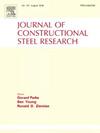Study on flexural performance of light steel keel composite wall with web openings
IF 4
2区 工程技术
Q1 CONSTRUCTION & BUILDING TECHNOLOGY
引用次数: 0
Abstract
Light steel keel composite wall with web openings is a new type of wall plate with thermal insulation properties, which helps to prevent the waste of resources related to the “thermal bridge effect.” However, the presence of web openings inevitably affects wall mechanical performance. This research investigates flexural performance parameters of eight light steel keel composite walls, seven with web openings and one without, through flexural testing. In addition, ABAQUS finite element software is used to simulate these walls, and it is found that the calculated load-deflection curves are in good agreement with the experimental results, which verifies the accuracy of the finite element simulation. Furthermore, the range of parameter was expanded, and the finite element models of 24 walls with web openings were established. The effects of keel thickness, keel web height, number of keel openings, and opening length on the mechanical properties of these walls were examined. Furthermore, the flexural stiffness, ultimate bearing capacity, and failure mode of the walls under different parameters were analyzed. The analysis reveals that increasing the keel thickness and keel web height substantially enhances the mechanical properties, with the flexural stiffness improving by 121.57 % and 167.64 %, respectively, and ultimate bearing capacity increasing by 115.62 % and 111.78 %. Conversely, increasing the number and length of openings considerably reduces the ultimate bearing capacity, with the maximum flexural stiffness decreasing by 42.40 % and 42.44 %, respectively, and ultimate bearing capacity declining by 26.86 % and 28.29 %, respectively.
求助全文
约1分钟内获得全文
求助全文
来源期刊

Journal of Constructional Steel Research
工程技术-工程:土木
CiteScore
7.90
自引率
19.50%
发文量
550
审稿时长
46 days
期刊介绍:
The Journal of Constructional Steel Research provides an international forum for the presentation and discussion of the latest developments in structural steel research and their applications. It is aimed not only at researchers but also at those likely to be most affected by research results, i.e. designers and fabricators. Original papers of a high standard dealing with all aspects of steel research including theoretical and experimental research on elements, assemblages, connection and material properties are considered for publication.
 求助内容:
求助内容: 应助结果提醒方式:
应助结果提醒方式:


